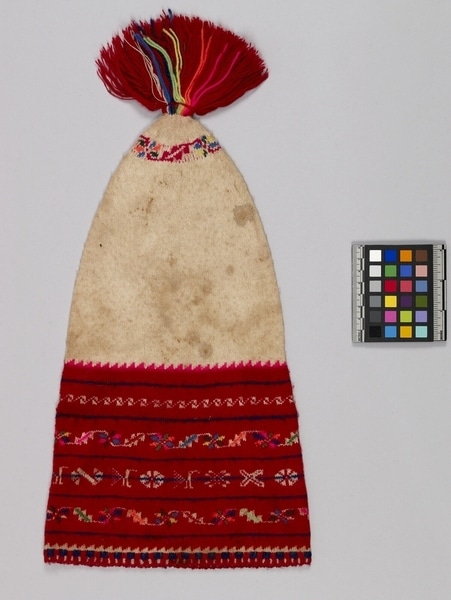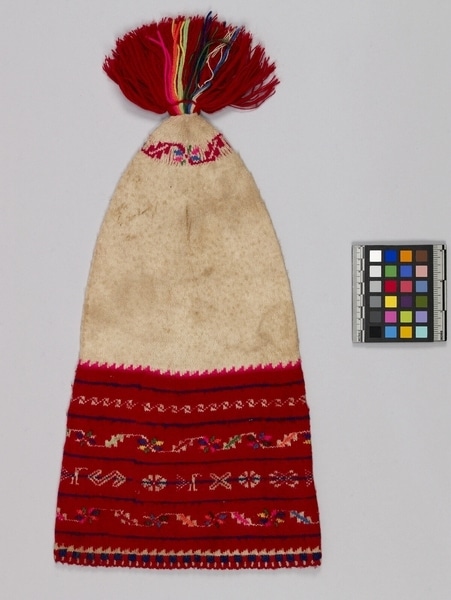Hat Item Number: Sf933 from the MOA: University of British Columbia


Description
Conical shaped stocking cap with a predominant red tassel on top. The upper portion is white with one pattern band near the tassel; the lower portion is red and divided into four pattern bands. Two pattern bands repeat a floret motif connected by a stepped diagonal. One pattern band has motifs of six-part circles, profile standing birds, s and z shapes and crosses. The final pattern band has interlocking s shapes. The patterns are orange, pink, blue, green, yellow, orange and navy. Cap is dirty and pilled.
History Of Use
The colour, extent of patterning, shape and the manner in which chullus or caps are worn signal differences in age, sex and status of the wearer. Females wear chullus in early childhood, but only males wear them later in life. Traditionally, knitting is done only by men and boys, formerly for chullus, but recently also for vest fronts, coin purses, gloves, ties, vests and sweaters which are sold to tourists.
Specific Techniques
Plain knitting done circularly on five needles with extra colours carried on the inside for local colour areas.
Narrative
Made by Esteban Huatta Cruz and used for one year by his 3 year old son, Selvano. Selvano was quite young to be wearing this style of cap but his cap with a brim was purchased the previous year.
Cultural Context
Young male; everyday; fiesta.
Iconographic Meaning
The range of motifs refers to local geography and landmarks, ecology, fecundity as well as luck. The six part circle refers to the division of land into six sections on Taquile and the rotation of crops and fallow periods. The s or z shaped reverse curve can refer to the boat port or other objects that contain the idea of turning or returning such as a recurved potato hook. The cross or x-shape can refer to the warping cross in weaving, the crossroads or other intersections. The stepped diagonal lines refer to stairs on the steep island, but also to the connection with the afterworld in a particular myth. The motifs represent basic concepts or interrelationships and may have different particular references.
Item History
- Made by Esteban Huatta Cruz (Maker) in Taquile, Puno, Peru during 1984
- Collected by Elizabeth L. Johnson during 1984
- Owned by Elizabeth L. Johnson before June 13, 1984
- Received from Elizabeth L. Johnson (Seller) and Museum of Anthropology Shop Volunteers (Funding source) on June 13, 1984
What
- Name
- Hat
- Identification Number
- Sf933
- Type of Item
- hat
- Material
- synthetic fibre and dye
- Manufacturing Technique
- knitted and sewn
- Overall
- height 47.1 cm, width 22.5 cm
Who
- Culture
- Quechua
- Creator
- Esteban Huatta Cruz (Maker)
- Field Collector
- Elizabeth L. Johnson
- Previous Owner
- Elizabeth L. Johnson
- Received from
- Elizabeth L. Johnson (Seller) and Museum of Anthropology Shop Volunteers (Funding source)
Where
- Holding Institution
- MOA: University of British Columbia
- Made in
- Taquile, Puno, Peru
When
- Creation Date
- during 1984
- Collection Date
- during 1984
- Ownership Date
- before June 13, 1984
- Acquisition Date
- on June 13, 1984
Other
- Item Classes
- textiles
- Condition
- fair
- Accession Number
- 0992/0007